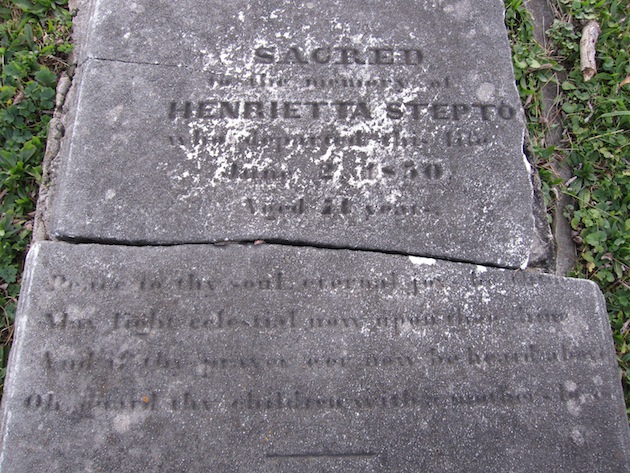
Holy Rood Cemetery, Section 19, Lot 172
The earliest record of Henrietta Steptoe in the District of Columbia is in 1805, when a Georgetown coffin maker entered in his ledger that he had made a coffin for “Henrietta Steptoe’s child.” Two years later, when Steptoe’s daughter, Mary Ann, was baptized at Holy Trinity Church in Georgetown two years later, the name of the father was not recorded. The child’s godmother was her older sister, “Rebecca Stepton,” who appears in the baptismal register again in 1810: “baptized Thomas natural son of Rebecca Stiptoe born Sept. 29, last. living at Georgetown.” As Rebecca Lee, Henrietta’s older daughter married Andrew Barker, four years later.
William King’s Mortality Book, December 20, 1805, p. 9; Holy Trinity Church, Baptisms, 1805-1834 (old book), pp. 26 37, Holy Trinity Church Archives, Georgetown University Library; Homer A. Walker, Historical Court Records of Washington, D.C. (1955). My thanks to Steptoe family historian, Jack Fallin, whose research suggests that Henrietta Steptoe was manumitted in Virginia by a member of the Lee family in about 1801.
In 1829, Henrietta Steptoe was warned that taxes were due on her house. “Will be exposed to Public Sale … to satisfy the Corporation of Georgetown, D.C. for taxes due … Henrietta Steptoe––part of lot No. 60 in Peter, Beatty, Threlkeld & Deakins’ Addition, 56 feet 6 inches on First Street––Small Brick House.” The outstanding $2.75 appears to have been paid; one year later, Steptoe is the head of a two-person household that consists of herself, age 36-54, and a young woman, age 10-23. (This may be a servant, as there is also a young woman, aged 10-23, in Steptoe’s 1840 household.) The 1830 Georgetown directory lists “Steptoe, Henrietta, midwife, First street, opposite Catholic church.”
“Collector’s Sale,” National Intelligencer, June 26, 1829, p. 1; “Henrietta Steptow,” Georgetown Assessments, 1835-1839, p. 158, National Archives; 1830 Census, Georgetown, D, C., p. 173; 1840 Census, Georgetown, D. C., p. 183.
In 1839, Henrietta Steptoe went before a magistrate who could vouch for her, and secured a Certificate of Freedom for herself, and for her daughter, who was now Mary Ann Tritt. In the document, John Marbury of Georgetown swears that he has known Mary Ann Tritt for about ten years, and her mother, Henrietta Steptoe, for about twenty-one years. Both women are light colored, and both live in Georgetown. Mary Ann is about thirty-one years old. Henrietta has recognized Mary as her child and “both have passed and are universally received and known by the inhabitants of Georgetown as free persons.”
Certificate of Freedom No. 1722, recorded October 29, 1839, Dorothy S. Provine, District of Columbia Free Negro Registers, 1821-1861, Vol. 3, p.165.
“At Georgetown, D.C., on Sunday, the 2nd instant, Henrietta Steptoe, aged 71 years. Near fifty years of her life were devoted exclusively to nursing the sick. By her assiduous, kind, and intelligent discharge of the duties of her humble office, she gained the confidence and affectionate respect of all who knew her. Few have contributed so largely as herself to alleviate the pains of the sick; her life has been spent in doing good; she will be long remembered as an humble friend and faithful nurse. Her funeral will take place at 10 o’clock A. M., (to-day,) at the house of her daughter, Mrs. Barker, on 4th st. in Georgetown.” Steptoe’s administrator was a prominent Georgetowner. “In the case of Henry C. Matthews, administrator of Henrietta Steptoe … with the approbation of the Orphan’s Court … final settlement of said estate, and for the payment and distribution … of the assets in the hands of the administrator … creditors and heirs … are hereby notified to attend … and file their claims, or they may be excluded.” A handsome ledger stone marks Steptoe’s grave in Holy Rood Cemetery.
HENRIETTA STEPTOE
Died June 2, 1850, Age 71
Peace to thy soul eternal be thine,
May light celestial now upon thee shine
And if thy prayer now be heard above
Oh, guard thy children with a mother’s love.
“Death,” National Intelligencer, June 5, 1850, p. 4; “Orphan’s Court,” National Intelligencer, November 25, 1851, p. 4; H. C. Mathews, 1860 Census, Ward 2, Georgetown, D. C., p. 74; “Deaths,” National Intelligencer, April 30, 1862, p. 1; Holy Rood Cemetery, section 19, lot 172.
Although Steptoe’s obituary had stressed her nursing of the sick, it was as a midwife that a prominent Washington physician later remembered her. “[I] began practice in this city when a trained obstetric nurse could not be obtained except as a special favor of one or two physicians who had educated a few for their own employment. It is true there were a few venerable and antiquated old prodigies, garrulous with gasconade and portentous advice, who would only honor an engagement among people of “quality.” Aunt Phillis and Henrietta Steptoe had risen to the dignity of Madame Lachapelle, and their vernacular and oracular dispensations were implicitly believed and accepted as the rule of conduct in the lying-in chamber of high life.” What rankled Dr. Busey about Steptoe––as his allusions to the Anti-Tom novel Aunt Phillis’s Cabin, and to the celebrated French obstetrician, Marie-Louise Lachapelle, make clear––was that the upper-class women they were both competing for preferred to put themselves in the hands of a colored midwife.
Samuel Clagett Busey, Personal Reminiscences and Recollections of Forty-six Years’ Membership In the Medical Society of the District of Columbia, and Residence in this City (1895), pp. 343-4.
___________________________________________________________
Carlton Fletcher
The citation and acknowledgement of my research is greatly appreciated.
All rights reserved.